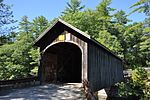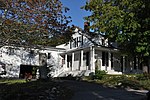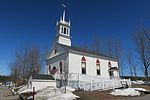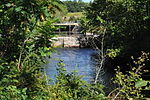Great Falls Historic District
Buildings and structures in Windham, MaineFederal architecture in MaineGreek Revival architecture in MaineHistoric districts in Cumberland County, MaineHistoric districts on the National Register of Historic Places in Maine ... and 3 more
NRHP infobox with nocatNational Register of Historic Places in Cumberland County, MaineUse mdy dates from August 2023

The Great Falls Historic District encompasses the remains of an early 19th-century mill hamlet in Windham, Maine. On the east bank of the Presumpscot River north of Windham Center Road are a cluster of three houses from the period, as well as the archaeological remains (most visibly building foundations) of a few mills that lined the river at the falls just north of the road. The district was listed on the National Register of Historic Places in 1995.
Excerpt from the Wikipedia article Great Falls Historic District (License: CC BY-SA 3.0, Authors, Images).Great Falls Historic District
Windham Center Road,
Geographical coordinates (GPS) Address Nearby Places Show on map
Geographical coordinates (GPS)
| Latitude | Longitude |
|---|---|
| N 43.8025 ° | E -70.446944444444 ° |
Address
Windham Center Road 7
04062
Maine, United States
Open on Google Maps







